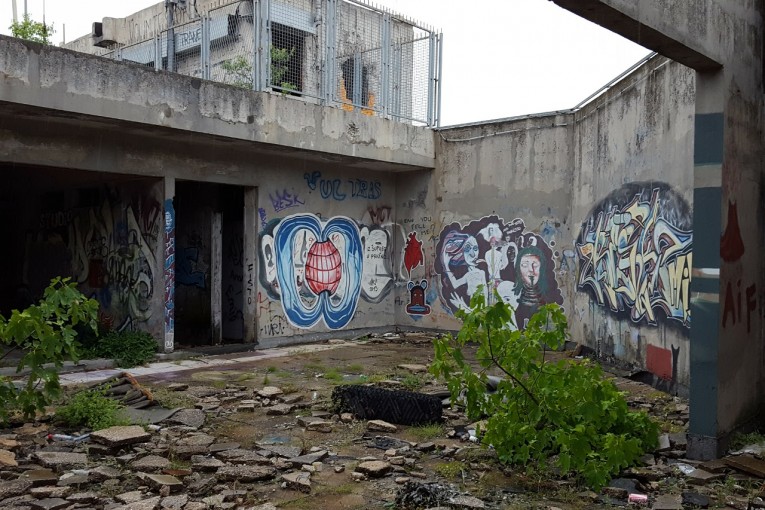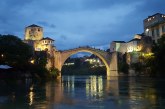
“The war threw my country back 300 years”. Very matter-of-fact, our guide told us his stories of living through the Siege of Mostar and the war that destroyed most of the city, and yes, of the bitterness that still lies beneath the surface for the devastation and loss that pitted brother against brother, Croats against Bosniak Muslims in the senseless war that ended in 1994.
The War Tour
Our guide was Žika and our War Tour through Hostel Nina. Over the course of the next 4 hours we were driven to amazing sites, guided through a bombed out building turned sniper tower, and told a history that I knew little about. And not just any history, a history from someone who lived through the war, was shot twice, saw many friends buried, and knew people on both sides of the conflict.
Hum Hill
High above Mostar, you can’t fail to notice an immense cross on top of Hum Hill, our first stop on the tour. It doesn’t take imagination to see how easy it was to target the Muslim east side of the river from this position high above.

High above Mostar on Hum Hill
Zoom view of Mostar from Hum Hill
The 100 foot high cross on Hum Hill doesn’t really represent religion, Žika explains. It’s about domination of west Mostar’s Catholic Croats over the east Mostar Muslims. The Croatia Coat of Arms also appeared on a mountain slope across the valley. An in your face move, keeping the hate alive.

Hum Hill Cross with Croatia Coat of Arms
Žika warned us not to stray from the path, this area was heavily mined and the only safe path still was the rocky road we walked from the cross to take a look at a bunker.
“Have you heard of Russian Roulette?” Žika asked. “Here, we had Belgrade Roulette”. That was where prisoners would be told they could gain their freedom, just ride this motorcycle across this field and if you make it you’ll be free. Of course they never made it.

Hum Hill bunker
View from bunker on Hum Hill
Land Mine danger sign hanging in a tree
A lone tourist was wandering around in the field near the cross, he’d walked up by himself from the town below and didn’t have a clue his desire for a walk in the countryside might have been his last, not until Žika hailed him and impressed on him that you don’t wander off the roads in Bosnia. The country was heavily mined and yes, they are still there.
Why aren’t there any signs warning people? We asked.
“There were signs, we keep putting up signs but tourists keep stealing them” Žika says, and told us once he caught a couple in the act of removing a sign “for a souvenir”. Indeed, on the drive back down the hill, there was one of the Land Mine Danger signs, hanging in a tree. A prank, and people’s lives were at stake.
The Secret Hanger
Our next stop was by the small Mostar airfield to what was once a hidden hanger cut all the way through a mountain. Building the fighter jets was secretly done in a nearby “aluminum” factory and the jets stored deep in the under-mountain hanger. The entrances on both sides of the mountain were camouflaged with paint and fake styrofoam boulders designed to make the entrances disappear to the casual observer. You could still see what was left of the huge blast doors, and deep within the enormous cavern there’s what used to be a bunker living quarters, now just destroyed empty rooms and the remnants of showers.

Hidden hanger and bunker
Broken glass, debris, water and dark, you need a flashlight once you get beyond the entrance. We walked completely through the hanger and out the other side to another entrance camouflaged like the first.
The Sniper Tower
We returned to Mostar to the west side (the Croat side) near the beautiful historic secondary school called the Old Gymnasium (Gimnazija Mostar). The building was completed in 1898 during the Austro-Hungarian occupation of Bosnia and Herzegovina, featuring Moorish Revival architecture.
Now both Bosnian and Croatian students attend the school, trying a social experiment to integrate the two different ethnic groups.

Gymnasium Mostar and Spanish Square
The Spanish Square is dedicated to 22 Spanish members of the UN peacekeeping force who lost their lives in the war.
The Glass Bank turned sniper tower
If you’re not comfortable with heights, jumping over walls, and a little climbing, you might want to skip the inside of the sniper tower.

Inside the sniper tower
After a climb of 7 floors past plenty of interesting graffiti, you come to the level where snipers brought horror down upon the people across the river. No one was safe. If you could be seen you were a target.

Mostar sniper position; View from the sniper hole; Empty shell casings under foot
A climb up to the very top leads to views down into the roofless bank building and the sniper den, and over Mostar.
Peering down into the roofless Glass Bank building (sniper tower)
Views of Gymnasium Mostar and Spanish Square from the sniper tower
The New Muslim Cemetery
Our last sad history stop on the tour was the New Muslim Cemetery and the graves of the Legendary heroes of the Bosnian resistance in the first row, all from the same unit. The graves without a deceased date are because the bodies have never been found.

Legendary heroes of the Bosnian resistance
Wrapping up the War Tour
Ending the tour on an upbeat, we stopped in at the diving club in the Halebija Tower at the Old Bridge for a look at some of the pictures of this historic tradition of diving off the bridge. Too dangerous on this rainy day for anyone to be diving, we headed over to Žika’s bar for a shot of rakija, a homemade brandy, a short film of scenes from the war, and despite the somber subject matter of the tour – a lot of good cheer and hope for the future of Mostar.
There are plenty of tours in Mostar that can show and tell the story of the horrific war and siege of Mostar, but I can’t imagine a better one than that given by Žika. One of the top experiences of this trip, I’ll never forget it.

